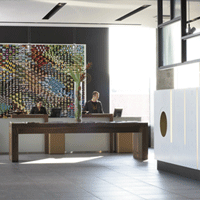Hoteliers explore new front-desk design options
The front desk itself is simple and sleek. Combining frosted glass with wood and stainless steel accents, it’s contemporary in design and set low so that it’s functional as well; you can take a load off if you want, sitting down on a stool for an espresso while you find out where the local hotspots are. Staff members wear jeans, and don’t be too alarmed if one says goodbye with a high-five.
For those who have never checked in to Groupe Germain’s ALT Hotel Quartier DIX30 in Montreal, the experience at the front desk may be surprising. But then, if you ask Hugo Germain, director of Development for ALT Hotels Canada, guests today aren’t exactly looking for the tried and true, at least when it comes to the staid, structured check-in experiences of yesteryear.
“Before, front desks were very formal, very rigid spaces,” says Germain, who launched the ALT brand with the inaugural 158-room ALT Hotel Quartier DIX30 in September 2007. “We reduced the space the desk was taking. It’s still very long but it’s lower and made from lighter material, and there’s more transparency. The way it’s designed enables our staff to multitask more, to do things like serving coffee to a guest and going out to the lobby to talk to people. We try to encourage staff to have much more interaction with people.”
ALT isn’t the only hotel brand that’s ditching big, imposing front-desks, and replacing them with models that are easier to navigate around; allowing staff better accessibility as they come out to help guests with their luggage or hand them their key. And just as the desk has changed, expectations for staff have as well. After all, checking in today is more than just a simple meet and greet. Like FBI profilers, front-desk personnel are expected to read guests and ascertain their individual wants and needs at every check-in occasion, helped along by new technology that puts customer preference details at their fingertips. And while automated kiosks are the preferred method for some experienced travellers, a majority of customers still seem to prefer the service that only a living, breathing person can offer.
The front desk, after all, is a hotel’s first impression. It’s an impression that every hotelier hopes will stick — through a guest’s stay and beyond. Guest comments at the ALT Hotel Quartier DIX30 run along the lines of “refreshing,” Germain says. “Everybody’s looking for a friendly experience,” he adds.
Paul Gardian couldn’t agree more. In fact, the executive director of Brand Operations with Delta Hotels says that guests are looking to make that initial, amiable connection more than they ever have before. “I think speed and efficiency, for a certain group of your customers — for your road-warrior-type business travellers — is certainly something they value,” Gardian says. “But with [airport] security being the way it is, travel time being the way it is as well, a friendly face and great conversation — be it short, be it long — is something that gets customers off to a great start.”
The best hotels always look for ways to create memorable first impressions. For one, Delta, like other hotel chains, is teaching front-desk personnel how to read customers to determine what type of check-in they’re looking for. But they’re also changing their front-desk designs, trying to narrow the space between staff and the customers they’re servicing. Case-in-point: about a decade ago, Delta was one of the first to introduce the ‘pod’ system of front-desk design, which were smaller, individual desks meant to create a more personable experience. Today, the pod is popular worldwide and is still used by Delta at some of its locations, including its Delta Centre-Ville site in Montreal and Delta Brunswick in Saint John. The pods have evolved — originally designed to accommodate one person, the newer Delta pods now accommodate two — but the purpose behind them hasn’t: breaking down the barrier between guest and staff, and to make it easier for staff to move in and out from behind to interact face-to-face with their customers.
But the pod system, says Gardian, still isn’t perfect. One problem he points to is that staff needs to be properly trained to use them to their maximum benefit. It’s a problem that Delta faced from the beginning, as staff members continued to work within the pods the same way they’ve worked behind traditional front desks, staying behind the barrier instead of walking around to interact with guests. “We just assumed we would take down the barriers and that employees would automatically come around,” he says
Gardian is also skeptical about automated kiosks — which are designed to eliminate that personal experience altogether for a faster, more efficient check-in that some of the “road warriors” he talks about are looking for. Although the technology is getting better, he says Delta is holding off on introducing self check-ins until they’re fine-tuned.
Janis Cannon, vice-president of Global Brand Management for InterContinental Hotels Group’s (IHG) Hotel Indigo brand, has also been slow to jump onto the automated-kiosk bandwagon. For her it’s a matter of function; right now the kiosks don’t offer enough function to replace the front-desk experience in its entirety, she says, and until it does it’s more efficient to continue with the status quo.
Guests wading through the check-in experience want more than just a key, after all. They’re trying to orient themselves and find out about hotel’s amenities, as well as the local area. “They’re still going to visit a desk to get that information,” says Cannon, who oversees 26 Hotel Indigo locations, including one in Ottawa, with another scheduled to open this year in Toronto. “So we actually are improving efficiency by not having a kiosk, because we take care of whatever their personalized needs are at that point.”
Besides, the front desk is an important aspect to the Hotel Indigo brand and image. All locations feature curved desks that allow easy access in and out for staff, although the designs themselves vary from city to city; the Ottawa location has a desk of golden-stained white oak veneer with blue granite countertops, while locations across the U.S. have much different desks, from dark espresso-stained cherry veneer in Fort Myers, Fla., to espresso-stained white oak veneer with countertops of cream concrete and recycled glass and oyster-shell aggregate in the new San Diego location.
While the front desk itself may be a key component to the Hotel Indigo brand, though, last year its parent company, InterContinental Hotels Group, did experiment with checking in through SMS text-messaging last year. But while there was interest in the pilot project, Cannon says, in the end, people still preferred to check-in at the front desk. “People want that personal interaction, because they have questions,” she says.
And while kiosks may not be used in Hotel Indigo locations, other properties are embracing the self-serve kiosk. For example, in the recent redesign of the Marriott Downtown Eaton Centre in Toronto, both pods and kiosks have been introduced. The kiosks are “fairly popular,” says the hotel’s director of operations Frank Strippoli. An added function that allows guests to print boarding passes in addition to checking in is especially appealing to the hotel’s business guests, he adds. “After travelling for 14 hours, they don’t want to talk to anybody,” he says.
Back at ALT Hotel Quartier DIX30 in Montreal, though, Hugo Germain has made the decision not to introduce automated kiosks, at least for the moment. For him, the personal and spontaneous service at the front desk is part of the ALT experience, and will be as he continues to roll the brand out through the country, starting with a Toronto location scheduled to open later this year. That face-to-face interaction helps to create an impression and to build a guest’s experience with the brand, Germain says. He doesn’t expect that to change in the near future. “We feel that human interaction is a key to our business model,” he says. “We’re going to protect that as long as we can.”





















